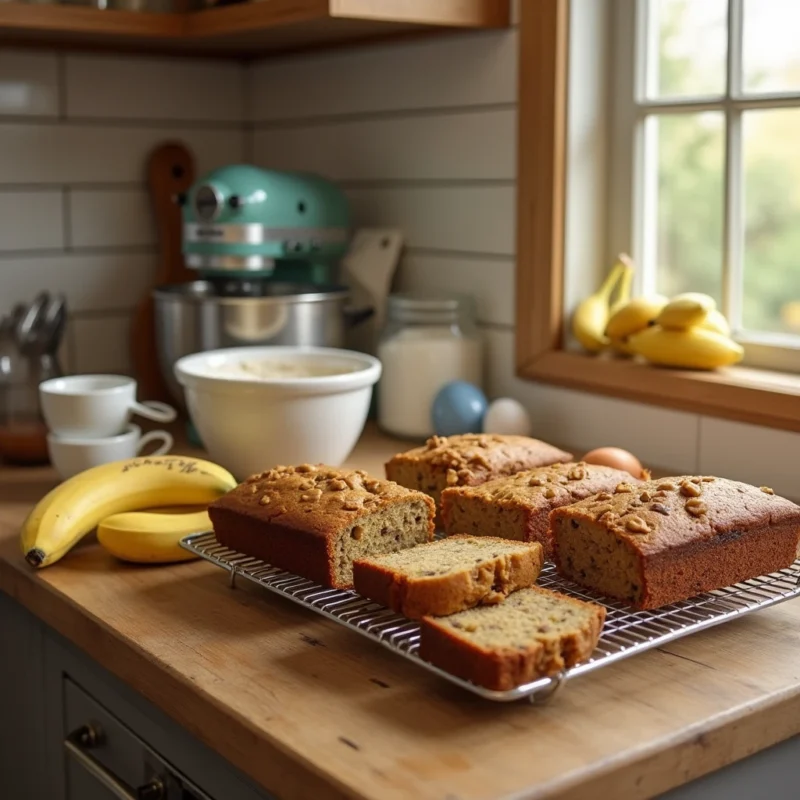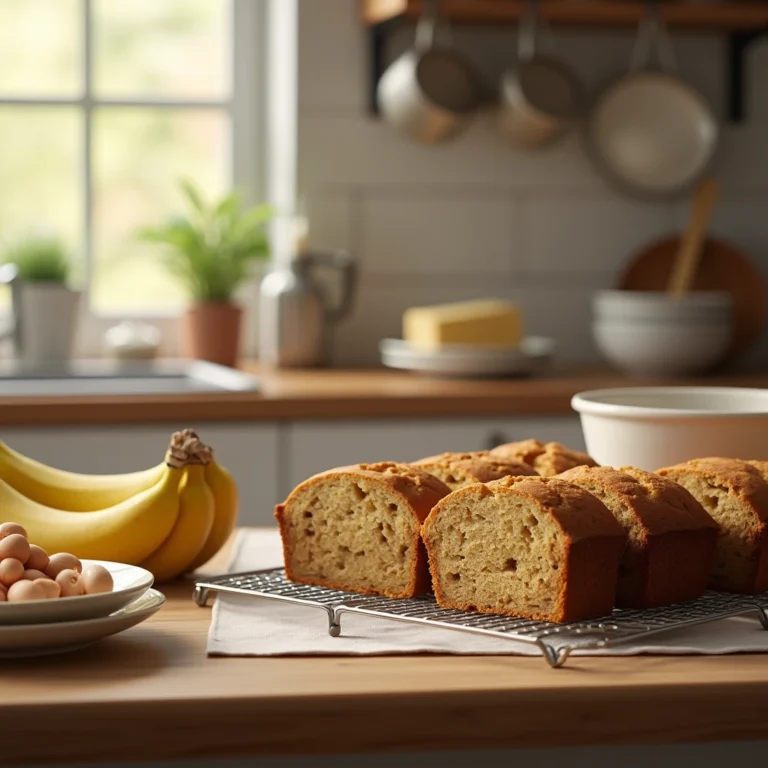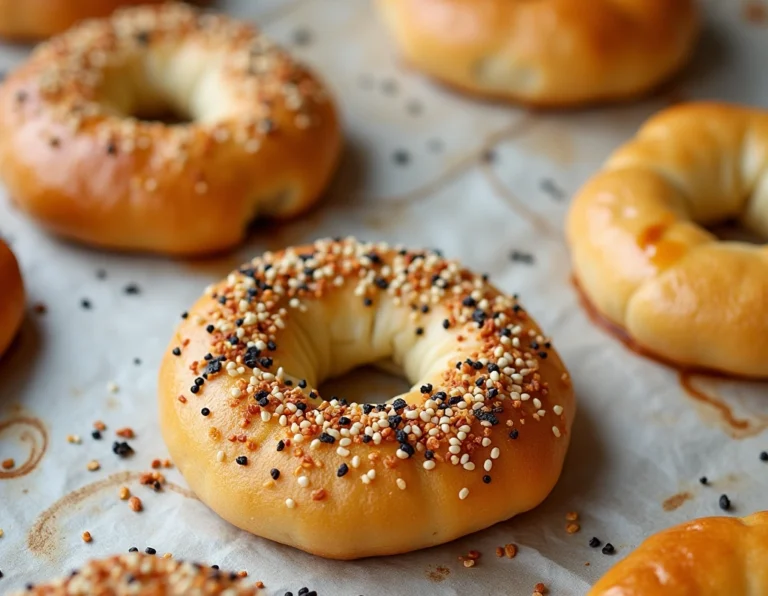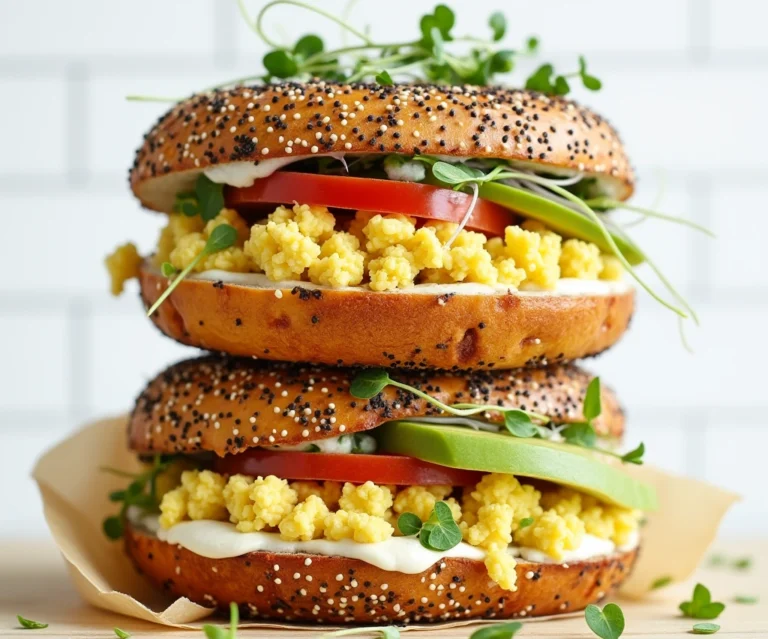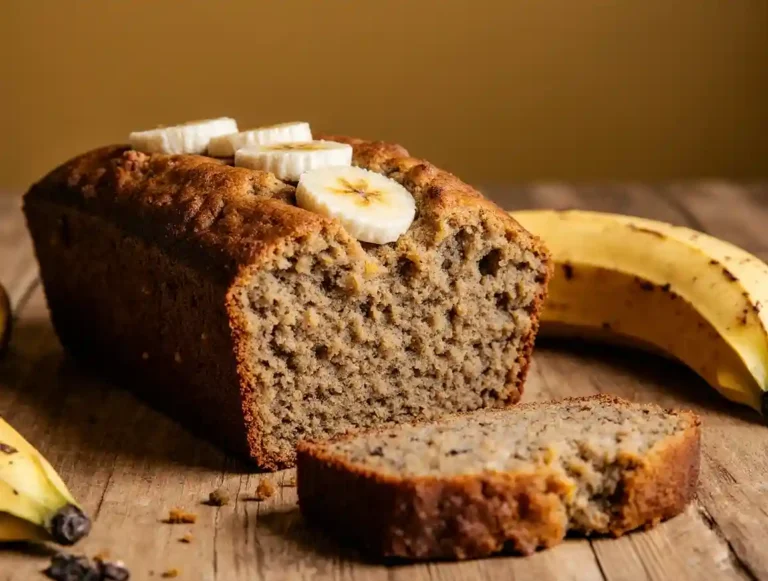What Are the Ingredients of Banana Bread? Unlock the Secret to a Perfect Loaf!
Curious about what are the ingredients of banana bread? Learn how to make a moist, delicious loaf with the right ingredients every time. Contents hide 1 Introduction: What are the ingredients of banana bread? 2 The Core Ingredients for Banana Bread 2.1 Bananas: The Heart of Banana Bread 2.2 Flour: Choosing the Right Type for…
Curious about what are the ingredients of banana bread? Learn how to make a moist, delicious loaf with the right ingredients every time.
Introduction: What are the ingredients of banana bread?
Banana bread is a beloved, classic treat that has been cherished for generations. This simple yet delicious baked good is made using ripe bananas, which not only add sweetness but also a moist texture, making it a perfect comfort food for any occasion. The charm of banana bread lies in its versatility—it can be enjoyed for breakfast, as a snack, or even as a dessert. Whether you prefer it plain or with added ingredients like nuts or chocolate chips, banana bread has something for everyone.
The history of banana bread can be traced back to the early 20th century when the rise of baking powder and soda as leavening agents revolutionized home baking. Initially, banana bread was an innovative way to use overripe bananas that might otherwise go to waste. Over time, it evolved into a popular family recipe, with various tweaks and variations emerging in kitchens across the world.
What makes banana bread particularly appealing is its straightforward ingredients and simple preparation. Even novice bakers can confidently create a loaf, and the sweet aroma that fills the kitchen as it bakes is irresistible. With minimal effort and basic pantry staples, banana bread provides a warm, comforting treat that never goes out of style.
In this article, we’ll explore the key ingredients that make up this classic recipe, offering tips on how to enhance your banana bread with additional flavors and healthier alternatives. Whether you’re baking for the first time or looking to perfect your recipe, you’ll find everything you need to make the perfect banana bread.
Explore more in our guide to the banana bread formula and healthy variations.
The Core Ingredients for Banana Bread
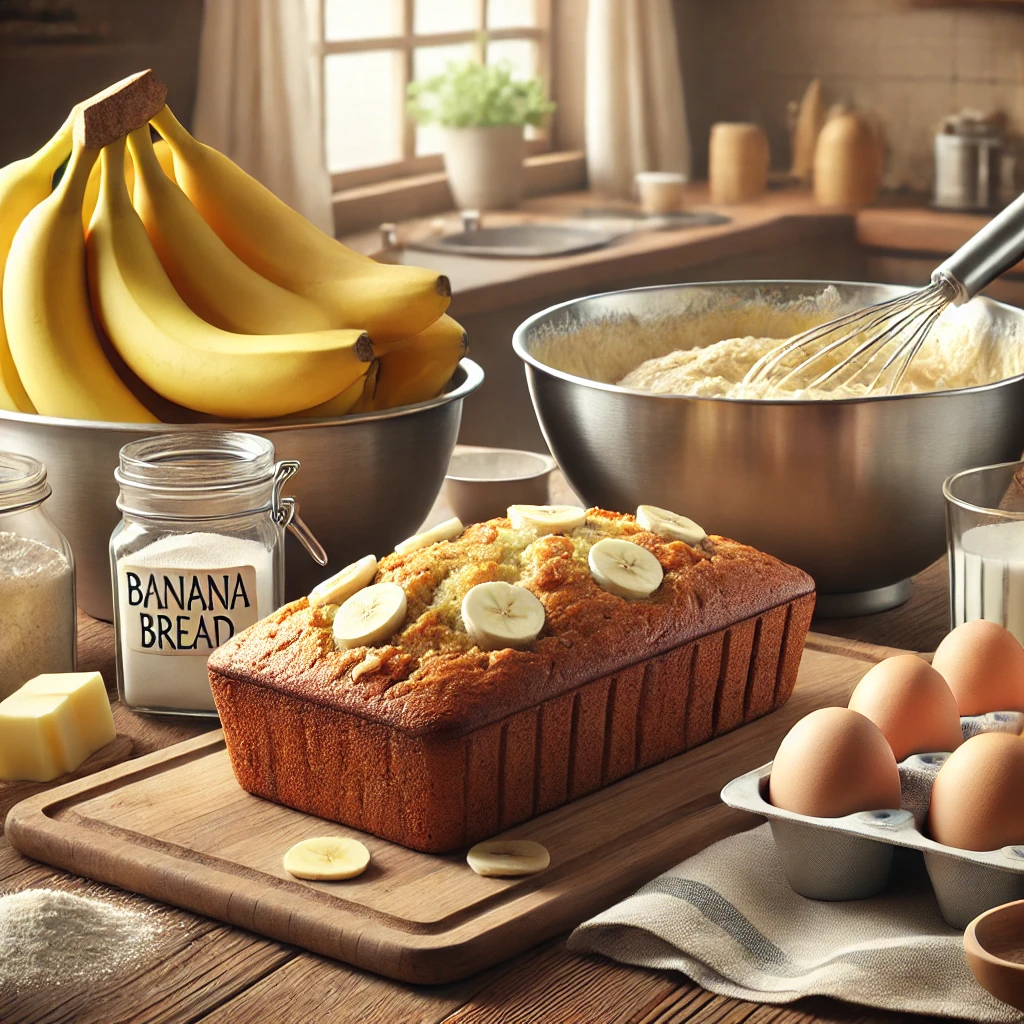
Banana bread is a straightforward recipe that requires just a few essential ingredients to come together. Each ingredient plays a crucial role in ensuring the bread turns out moist, flavorful, and with the perfect texture. Below, we’ll discuss the core ingredients that form the foundation of a delicious banana bread.
Bananas: The Heart of Banana Bread
The primary ingredient in banana bread is, of course, bananas. Overripe bananas are ideal for banana bread because they are naturally sweeter and softer than their fresher counterparts. Their high sugar content not only provides the necessary sweetness but also contributes to the bread’s moist texture. As a general rule, the more ripe the banana, the better. Look for bananas that are speckled with brown spots or even fully brown. These bananas will mash easily and blend seamlessly into the batter, adding both flavor and moisture.
Flour: Choosing the Right Type for Banana Bread
Flour is another crucial ingredient in banana bread, providing structure to the loaf. The most commonly used type of flour is all-purpose flour, which gives banana bread its soft and tender crumb. You can also experiment with whole wheat flour for a denser, more rustic loaf or gluten-free flour blends if you’re looking to make a gluten-free version. However, all-purpose flour is the go-to choice for most banana bread recipes, as it ensures a balanced texture and rise without overpowering the bananas’ flavor.
Sugar: Different Varieties and Their Impact on Flavor
Sugar is added to banana bread to enhance its sweetness, balancing the natural sugars in the bananas. Granulated white sugar is typically used, but other sugars such as brown sugar or coconut sugar can also be incorporated for a slightly different flavor profile. Brown sugar, for example, adds a hint of molasses that can deepen the flavor of the banana bread. If you’re looking for a healthier alternative, you can use maple syrup or honey in place of white sugar, though this may slightly alter the texture and baking time.
Eggs: The Binding Agent in Banana Bread
Eggs are essential for binding the ingredients together in banana bread. They provide structure and moisture, helping the bread rise and keeping it from being too crumbly. Eggs also contribute to the richness of the bread, adding both flavor and texture. Most banana bread recipes call for two large eggs, but for a vegan version, you can substitute eggs with flaxseed or chia seeds mixed with water to achieve a similar binding effect.
Butter or Oil: Moisture and Flavor Enhancers
To keep banana bread moist and tender, a fat source is necessary. Butter is the most common fat used, adding a rich, flavorful element to the loaf. Alternatively, vegetable oil, coconut oil, or even unsweetened applesauce can be used. While butter contributes a delightful flavor, oil tends to make the bread a bit moister. Coconut oil, in particular, adds a subtle coconut flavor that pairs wonderfully with bananas. You can adjust the fat content depending on your desired texture and flavor.
Baking Powder vs. Baking Soda: What’s Best for Banana Bread?
Leavening agents, like baking powder and baking soda, are what allow banana bread to rise while baking, giving it that soft, fluffy texture. While both baking soda and baking powder can work in banana bread, the choice depends on the acidity of the batter. Most banana bread recipes call for baking soda because bananas are naturally acidic, which activates the baking soda to help the bread rise. Baking powder, on the other hand, is a combination of baking soda and an acid and is typically used in recipes that lack acidic ingredients.
Choosing the right leavening agent is important for achieving the perfect rise. If you’re using baking powder, ensure you’re using the right amount, as too much can lead to a bitter taste, while too little can cause the bread to be dense.
Adjusting Ingredients for Healthier Banana Bread Recipes
While traditional banana bread is delicious, it can sometimes be higher in sugar, fat, and refined flour. Fortunately, there are several easy adjustments you can make to create a healthier version without sacrificing flavor. Whether you’re looking to reduce calories, add more nutrients, or cater to specific dietary needs, these ingredient substitutions will help you craft a lighter, more nutritious loaf.
Substituting for Healthier Fats: Coconut Oil and Applesauce
One of the easiest ways to make banana bread healthier is by replacing the traditional butter or vegetable oil with a healthier fat option. Coconut oil is a popular choice, as it provides healthy fats and a subtle coconut flavor that complements the bananas. It also adds moisture to the bread without the need for excessive sugar or butter.
If you’re aiming to reduce fat content further, applesauce can be used as a substitute for butter or oil. Unsweetened applesauce helps retain the moisture in the bread while lowering calorie content. You can substitute half of the butter or oil with applesauce to achieve a lighter loaf. Additionally, applesauce adds natural sweetness, allowing you to use less sugar in the recipe.
Making Banana Bread Gluten-Free
For those with gluten sensitivities or those following a gluten-free diet, it’s easy to adjust your banana bread recipe. Instead of using all-purpose flour, you can opt for gluten-free flour blends that are widely available. These flour blends are typically made from a combination of rice flour, potato starch, and tapioca flour, and they are designed to mimic the texture and behavior of wheat flour. You may need to experiment with different brands to find the best one for your banana bread.
Another gluten-free option is almond flour, which is made from ground almonds. Almond flour adds a slightly nutty flavor to the bread and creates a denser, more moist loaf. However, it’s important to note that almond flour doesn’t rise as much as all-purpose flour, so you might need to add extra baking soda or baking powder to help the bread rise.
Reducing Sugar: Natural Alternatives for Sweetness
Banana bread relies heavily on sugar for its sweetness, but if you’re looking to reduce refined sugar intake, there are several natural alternatives that can help. Overripe bananas already provide significant sweetness, allowing you to cut back on added sugar. To further reduce sugar, you can use natural sweeteners like honey, maple syrup, or stevia.
Honey and maple syrup not only provide sweetness but also add unique flavors that complement the bananas in your bread. If you choose to use these alternatives, you may need to adjust the baking time or consistency of the batter, as these liquid sweeteners can alter the texture of the loaf. Stevia, a zero-calorie sweetener, can also be used in small amounts to sweeten banana bread without adding any calories or sugar.
For a refined sugar-free option, you can experiment with coconut sugar, a natural sugar made from coconut palm sap. It has a lower glycemic index than regular sugar and provides a mild caramel flavor, which pairs beautifully with banana bread.
Adding Whole Grains: Using Oats and Whole Wheat Flour
If you want to increase the fiber content of your banana bread, consider using whole wheat flour instead of all-purpose flour. Whole wheat flour retains more of the bran and germ from the wheat, providing additional fiber, vitamins, and minerals. It will also give the bread a denser, more rustic texture, which some people prefer.
Another great addition to banana bread is oats. You can mix in old-fashioned rolled oats to add texture and fiber to your loaf. Oats will not only increase the health benefits of your banana bread but also help with digestion, as they are rich in soluble fiber. You can replace a portion of the flour with oats to boost the nutritional value without affecting the flavor too much.
If you’re unsure about soaking times or bread types, Serious Eats explains why oven-drying day-old bread like brioche or challah gives your French toast a crisp exterior with a tender interior.
Boosting Protein: Adding Greek Yogurt or Protein Powder
If you’re looking to increase the protein content of your banana bread, consider adding Greek yogurt or protein powder. Greek yogurt adds creaminess and moisture while packing in protein and probiotics, which can improve gut health. Adding a cup of plain Greek yogurt will provide an extra protein boost without altering the taste significantly.
For those who want a more substantial protein boost, protein powder can be added to the batter. Whey protein, pea protein, or plant-based protein powders are great options to increase the protein content in your banana bread. Start with a small amount, around 1/4 cup, and adjust depending on the desired consistency and taste.
By making these simple ingredient adjustments, you can enjoy a healthier version of banana bread that still maintains the delicious, comforting flavor we all love. Whether you’re cutting back on sugar, increasing fiber, or accommodating dietary restrictions, these tweaks will help you create a more wholesome loaf that’s perfect for a nutritious snack or breakfast treat.
Looking to switch things up? Try the classic banana nut bread recipe, or go tropical with the secrets to perfect Maui-style banana bread.
Common Mistakes to Avoid When Making Banana Bread
Making banana bread might seem like a straightforward task, but there are several common mistakes that can lead to disappointing results. Whether you’re a beginner or an experienced baker, being aware of these pitfalls can help you achieve the perfect loaf every time. Here are some of the most frequent banana bread mistakes and tips on how to avoid them.
Overripe vs. Under-ripe Bananas: Finding the Right Balance
One of the most crucial components of banana bread is the bananas themselves. Using overripe bananas is key to achieving that rich, sweet flavor and moist texture. However, using bananas that are too ripe—those that are mushy and overly brown—can result in an overly dense and wet loaf.
The ideal bananas for banana bread are those that are heavily speckled with brown spots but still hold their shape. These bananas are sweet, soft, and easy to mash, providing just the right amount of moisture and flavor without making the batter too runny.
Suggesting flour substitutes this guide to flour types can help you explore better baking options.
Overmixing the Batter: How to Avoid a Dense Loaf
Another common mistake when making banana bread is overmixing the batter. While it’s important to thoroughly combine the ingredients, overmixing can lead to a tough, dense loaf. This happens because mixing too much activates the gluten in the flour, which can result in a chewy texture rather than the light, soft crumb you want.
To avoid this, mix the batter just until the ingredients are combined. It’s okay if the batter is slightly lumpy—don’t worry about getting a perfectly smooth consistency. This gentle mixing will help you achieve a more tender loaf.
Using the Wrong Pan Size: Adjusting for the Perfect Bake
The size of the baking pan you use plays a significant role in the final texture and cooking time of your banana bread. If you use a pan that is too small, the bread may rise too high and then collapse. Conversely, a pan that is too large may cause the bread to bake too quickly and dry out.
A standard 9×5-inch loaf pan is ideal for most banana bread recipes. If you’re using a different size pan, you may need to adjust the baking time. A smaller pan will require more time in the oven, while a larger pan may need less time. Keep an eye on the bread as it bakes and perform the toothpick test to ensure it’s done.
Not Letting the Bread Cool Properly
It can be tempting to slice into your banana bread as soon as it comes out of the oven, but cutting it too early can result in a messy, crumbly loaf. Banana bread needs time to set and cool after baking, as this allows the structure to firm up. Cutting too soon can cause the bread to fall apart and lose its shape.
Let the bread cool in the pan for about 10 minutes before transferring it to a wire rack to cool completely. This will ensure the bread holds its shape and allows for cleaner, neater slices.
Baking at the Wrong Temperature
Baking banana bread at the wrong temperature can lead to uneven baking. If the oven temperature is too high, the bread may brown too quickly on the outside while remaining raw in the middle. On the other hand, baking at too low a temperature can result in a dense and undercooked loaf.
To avoid this, always preheat your oven before putting the bread in. Most banana bread recipes call for a temperature of 350°F (175°C), but it’s important to check your oven’s accuracy with an oven thermometer, as some ovens run hotter or cooler than the dial indicates. If you notice that the top of the bread is browning too quickly, you can cover it loosely with foil to allow the inside to cook without burning the crust.
Using Too Much Flour
It’s easy to add too much flour when measuring, which can lead to dry and dense banana bread. This often happens when flour is scooped directly from the bag, which can pack the flour into the measuring cup. The proper way to measure flour is by spooning it into the measuring cup and leveling it off with a knife to avoid packing it in.
Alternatively, you can weigh the flour for more accuracy. Typically, one cup of all-purpose flour weighs about 120 grams. Too much flour will prevent the banana bread from achieving the desired moist and tender texture, so it’s important to measure carefully.
Looking to switch things up? Try the classic banana nut bread recipe, or go tropical with the secrets to perfect Maui-style banana bread.
Frequently Asked Questions (FAQs)
Here are some common questions that many people have when making banana bread, along with helpful answers to ensure your baking experience goes smoothly.
How Can I Make Banana Bread Without Eggs?
If you’re looking to make banana bread without eggs due to dietary restrictions or preferences, there are several substitutes you can use. Common egg replacements include:
- Flaxseed meal: Mix 1 tablespoon of ground flaxseeds with 3 tablespoons of water and let it sit for a few minutes to form a gel-like consistency. This works well as a binding agent.
- Chia seeds: Similar to flaxseeds, chia seeds can be used to replace eggs in banana bread. Mix 1 tablespoon of chia seeds with 3 tablespoons of water.
- Applesauce: Use 1/4 cup of unsweetened applesauce as a substitute for each egg. This will add moisture and a slight sweetness to the bread.
Can I Use Frozen Bananas for Banana Bread?
Yes, you can absolutely use frozen bananas for banana bread! In fact, frozen bananas are often preferred because they become extra soft and easy to mash once thawed. To use frozen bananas, simply let them thaw in the fridge or at room temperature, then peel and mash them as you would with fresh bananas. Just be sure to drain any excess liquid before adding them to the batter to avoid making the bread too soggy.
Why Does My Banana Bread Turn Out Too Dry?
If your banana bread turns out dry, it could be due to a few different factors:
- Overbaking: Leaving the bread in the oven for too long can dry it out. Always check for doneness by inserting a toothpick into the center of the loaf. If it comes out clean, it’s done.
- Too much flour: Adding too much flour can make the bread dry and dense. Be sure to measure the flour correctly using the spoon-and-level method or by weighing it.
- Not enough moisture: Ensure you’re using ripe bananas, as they provide natural moisture. If the bananas are too firm, the bread might lack the moisture needed for a tender texture.
How Do I Make My Banana Bread More Moist?
To make your banana bread more moist, you can try these tips:
- Use overripe bananas: The riper the bananas, the more moisture they’ll contribute to the bread.
- Add extra fat: If you’re using a recipe with butter or oil, consider adding a little more fat to increase moisture. Coconut oil or applesauce can also help.
- Don’t overmix the batter: Overmixing can cause the bread to become dense and dry. Mix just until combined to keep the texture light and moist.
- Cover the bread with foil during baking: If the top of the bread starts browning too quickly, cover it loosely with foil to allow the inside to bake without drying out.
Can I Add Other Fruits to Banana Bread?
Yes, you can add other fruits to your banana bread to enhance the flavor and texture. Common additions include:
- Blueberries: Fresh or frozen blueberries add bursts of sweetness and color.
- Apples: Chopped apples can provide a nice crunch and additional sweetness.
- Pineapple: Adding crushed pineapple can give your banana bread a tropical twist.
Just make sure to adjust the baking time slightly, as additional moisture from fruits like pineapple can affect the overall texture of the loaf.
What’s the Best Way to Store Leftover Banana Bread?
To keep your banana bread fresh for as long as possible, follow these storage tips:
- Room temperature: If you plan to eat it within a few days, store the banana bread in an airtight container at room temperature.
- Freezing: For longer storage, wrap the banana bread in plastic wrap or aluminum foil and place it in a freezer bag. It can be stored in the freezer for up to 3 months. When ready to eat, thaw at room temperature or warm it up in the oven.
These frequently asked questions should help you troubleshoot any issues you encounter while baking banana bread and offer solutions to make your next batch even better!
Conclusion
Banana bread is a timeless and versatile treat, loved by many for its simplicity and delicious flavor. By understanding the core ingredients and how they contribute to the texture and taste, you can easily adjust the recipe to suit your preferences and dietary needs. Whether you prefer a classic version, a healthier alternative, or a fun twist with added ingredients, banana bread is a great way to use overripe bananas and enjoy a homemade snack. With the tips and guidance provided, you’re well on your way to baking the perfect loaf every time. Happy baking!

